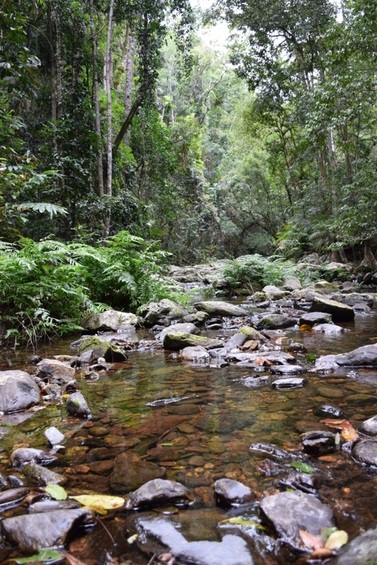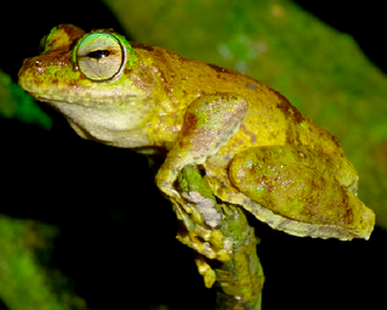Our Unique Kuranda Neighbourhood
|
Litoria myola is a very recent frog species. Learn about this recent ice age survival story through genetics, explained by Dr Conrad Hoskin. |
The right habitat for the Kuranda Tree Frog depends on many little things being just right. Just as we enjoy living in certain conditions, Kuranda Tree Frogs need particular conditions. Interestingly, these frogs need clean, gentle flowing riffles in rainforest edged streams to breed, with the males calling from favourite perches above the stream, enticing the females out of the surrounding rainforest, high up in the trees.
As residents and visitors, we expect our neighbours to respect us as we would respect them. You wouldn't dump your rubbish or chemicals in your neighbours’ back yards, just as you wouldn't expect them to clear the trees in your yard or fill your creek with sand instead. Kuranda Tree Frogs couldn't cope with any of these actions either. There are threats to their habitat This is why we are focussing on creating and maintaining a frog friendly neighbourhood. It is important we remember to respect all our neighbours so our neighbourhood will continue to be such a great place to live and visit.
We hope to report the continued good health of our rainforest streams and the health of the frog population through our long term frog-monitoring project.
Frog Friendly Property
Learn how you can make your property a refuge for frogs and other wildlife.
Australian Lace lid (Litoria dayi). Photo: Sylvan Calleja
Frog Monitoring Project
The aim of this monitoring project is to mitigate degrading frog environments. Of course, frogs are just the iconic species that indicate unseen environmental decline that can eventually lead to decline in other species, including human health. In October 2012, Kuranda Envirocare received funding from The Mohamed bin Zayed Species Conservation Fund (MBZ) to monitor [link to About the project/monitoring page?] the Critically endangered Kuranda Tree Frog (Litoria myola) and other endangered frogs in the Kuranda habitat.
|
Get involved!
What you will need:
· Thirty minutes of your time on site
· Sturdy footwear
· A head torch
· Practice listening to these frog calls [link]
· Kuranda Envirocare provides the rest of the training
Volunteers identify frogs, primarily by their calls. We also encourage YOU to listen out for the three target frogs identified by these calls and we would love it if you reported your location, time and date to us.
Contact us for all the details and you will receive monthly texts for frog watching
Kuranda Envirocare will coordinate the monitoring and manage the data. Both Kuranda Envirocare and Dr Hoskin will collaborate on analysing trends in the data. This grant will initiate the monitoring and fund the first 3 years and then other funding sources will be sought to continue the monitoring for at least 10 years.
This will be the first long-term community frog-monitoring project that we know of in Australia and certainly northeast Queensland.
Why Focus on Frogs?
1. Kuranda has several endangered rainforest frogs
2. One of these, the Kuranda Tree Frog (Litoria myola), is found nowhere else in the world
3. The frogs that need help are those that use the streams. The pond breeders are doing just fine.
4. Frogs are an excellent gauge of environment health.
5. Healthy frog populations indicates healthy populations of other species.
6. Frogs are iconic and locals and tourists love them.
Looking after stream frogs is easy. They just need healthy streams and some rainforest. And they need everyone to be careful about what happens upstream.
Why mention frogs in particular? The presence of frogs, especially endemic frogs, is an excellent gauge of the health of our rainforest ecosystem and waterways. They are also an iconic species, tourists and locals alike associate frogs with rainforest.
Keeping frogs healthy will mean the rest of the environment is healthier too. What happens upstream flows-on so let's make our Frog Friendly philosophy flow-on too!
About Litoria myola (The Kuranda Tree Frog)
The Kuranda Tree Frog breeds on small streams in the bioregion of the Wet Tropics World Heritage listed rainforest in north Queensland, Australia. The conservation status for Litoria myola, under the classification of the International Union for Conservation of Nature (IUCN), is Critically Endangered and Endangered under the Australian Environment Protection and Biodiversity Conservation Act 1999 (EPBC Act). The Common Mist Frog (Litoria rheccola) and the Lacelid Frog (Litoria dayi), otherwise known as Lace-eyed Tree Frog (Nyctimystes dayi), are both listed Endangered under the IUCN and the EPBC Act shared the Kuranda Tree Frogs habitat. However, the later frogs have not been identified in the last decade.
There are two classifications listed before critically endangered; Extinct in the Wild and Extinct (find out more).
These classifications are due to the very small total population and fragmented distribution as well small breeding populations of which thirteen are known. Only small portions are protected in conservation areas, the rest is largely on private land. Therefore, conservation of these species depend on the Frog Friendly [Link to book] activities within the community in the Kuranda region.
Species Conservation
The Mohammed bin Zayed Species Conservation Fund grant for the long-term monitoring of the threatened Litoria myola (Kuranda Tree Frog) follows on from previous grants to support habitats for endangered species in the Kuranda region such as the Mobile Muster.
A Community Action Grant from Kuranda Envirocare has also been successful in achieving a Caring For Our Country (Aust’ Govt’) Community Environment Grant 2013-2014 called the Frog Friendly Face for our Local Jum Rum Creek. This project will provide further restoration work to Jum Rum Creek.
t will also facilitate an education program for local landholders who may not be aware of the frog’s critically endangered status and will highlight activities that may contribute to frog decline such as sediment runoff or feral animal impacts. A frog information booklet is now available and with this, landholders can apply to have their properties assessed for inclusion on a local register of frog friendly properties.
Why are we doing it?
In a report on the disappearances of frogs in Australia, Campbell (1999) [link here to pdf] estimates that 13% (27 species) of Australia’s frog fauna are threatened, and of these, 8 species may have disappeared altogether. An additional 14 species give cause for concern. For most of these species, the causes of decline are not known or are poorly understood. Currently, we know little about what components of stream health impact on frogs in this region or in Australian streams more broadly.
It is also recommended that:
o A study of aquatic pollutants, particularly herbicides used near water bodies
o Record the distribution, abundance and conservation status of insufficiently known species
o Research the impacts of introduced fish and other feral animal predators
o Climate change impacts
o Captive breeding, successful rearing and husbandry techniques
o Promote public involvement and support interest from amateur groups
o The creation of an atlas and national working group of frog experts and the public to compile a national record of frog data and locations
o Determine if there are causal factors common to these declines and if any of these operate together
o A national working group for frog conservation is established.
This is why Kuranda Envirocare has made frog habitats a priority for riparian restoration and stream health.
References:
Campbell, A., (Ed.). 1999, Decline and Disapperances of Australian Frogs, Environmental Australia, Canberra.
Hoskins, CJ. 2007, Description, biology and conservation of a new species of Australian tree frog (Amphibia: Anura: Hylidae: Litoria) and an assessment of the remaining populations Litoria genimaculata Horst, 1883: systematic and conservation implications of an unusual speciation event., Biological Journal of the Linnean Society, Vol 91, pp 549-563.
Other Projects
|
|
|





